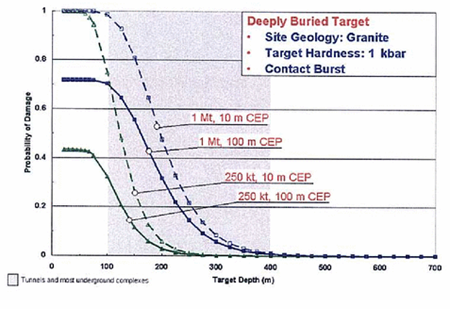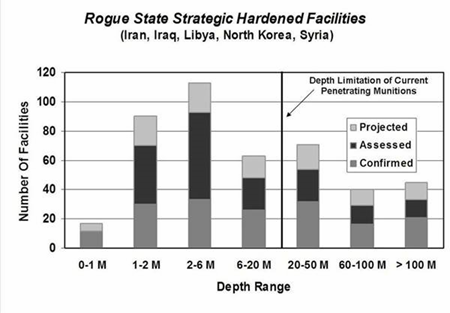Staring at the curve representing the effectiveness of contact bursts againt hard and deeply buried targets, I noticed the RNEP was designed to defeat tunnels and underground facilities between 100-400 m.

FIGURE 4.5 Effectiveness of contact bursts against some deeply
buried targets. Note: CEP=circular error probable (i.e. accuracy).
Source: Committee on the Effects of Nuclear Earth-Penetrator and Other Weapons, Effects of Nuclear Earth-Penetrator and Other Weapons (National Research Council, 2005) 4-12.
Let’s take a second look at the DIA chart showing “rogue state” HDBTs. There are just 20-40 HDBTs at depths of 100 M or more among Iran, Iraq, Libya, North Korea and Syria.
How many of the 20-40 could possibly be in Iran or Syria?
The extremely small number of “rogue state” HBDTs—and their likely geographic concentration in North Korea—raises two questions:
- Do we really plan to use 20 or 30 nuclear weapons with yields up to 1 MT against North Korea? Or is this about busting Russian and Chinese command and control facilities in a first strike?
- If Iran or Syria have few HDBTs—one or two each—could we consider alternative strategies?
Former DTRA Director Steven Younger proposes several alternative strategies to counter “superhard” targets too deep for even high-yield nuclear weapons:
Superhard targets, such as those found under certain Russian mountains, may not be able to be defeated reliably by even high-yield nuclear weapons. In this case, one might use a different strategy such as “functional defeat” in which power, communications, or other vital functions are eliminated or denied without the physical destruction of the main target. Alternately, one might use negotiations to eliminate a target, bargaining away a limited set of special targets for concessions on our part.
These are open questions—I still haven’t completely thought through the implications of this numerical and geographic information.
What worries me, is that I don’t think the Bush Administration has thought through the implications, either.


Well they have to do something with those B61’s in Europe! You know….why waste a perfectly good nuclear weapon! You said what? deactivate them? How dare you!
The RNEP is likely to be either a modified B61-7 (which was modified for the current Nuclear Earth Penetrator) or B83.
DOE keeps in storage 310 B61-7 and 120 B83 gravity bombs that could be modified for RNEP.
The nuclear warheads in Europe are different modifications of the B61.
So, rest easy: RNEP will not compete with our continuing efforts to defend Western Europe against Soviet aggression.
A quick question: I assume that our info on these sites comes from GPR? If so, do you happen to know the median scanning depth on georadar these days?
Yes they are a different Mod than the RNEP but not by that much and could very easily be retrofitted…..
I thought DOE wanted something with a 300 KT or so yield.
I’ll ask Hans Kristensen …
“I thought DOE wanted something with a 300 KT or so yield.”
Yea….. but the 170’s are being talked about over at the puzzle palace………
I learn something new everyday.
Thanks.
“Alternately, one might use negotiations to eliminate a target, bargaining away a limited set of special targets for concessions on our part.”
Your analysis about the RNEP being more useful against Russia and China than rogue states seems valid to me. However, I don’t understand how the above could be a plausible alternative to the RNEP. In a situation of nuclear war, can we expect that an enemy nation will be willing to negotiate away the handful of targets we’re technologically unable to destroy? If they were willing to so negotiate, would there be any possible way of verifying that the targets had indeed been abandoned in exchange for “concessions on our part”? Indeed, what concessions can possibly be made in a state of nuclear war?
Even Younger, in the article you quote, acknowledges that “our ability to negotiate away superhard targets would be very difficult at best.”
The “functional defeat” alternative to the RNEP seems much more plausible, though I’d have to see more explanation of it. Younger doesn’t go into much detail in the article. If power and communications for a superhard target are substantially more vulnerable than the target itself, doesn’t that defeat the point?
Do you know of a more in-depth analysis of the idea of functional defeat of superhard targets?
>>In this case, one might use a different strategy such as “functional defeat” in which power, communications, or other vital functions are eliminated or denied without the physical destruction of the main target.
I’ve wondered all along why they don’t use this strategy for all buried targets. They have to have ventilation shafts somewhere, those shafts are likely to be a different temperature than the surroundings and therefore good targets for infrared sensors.
It’ll get mighty stuffy after a smallish missile hit.
Michael Levi wrote a few paragraphs about functional defeat (pp.20-21) and current methods to detect underground facilities (pp.9-11).
I owe him an e-mail, actually.
As for the diplomatic strategy, ASD/PA Ken Bacon told reporters the US stopped construction at the Tarhuna facility in Libya:
The B61 series are tact nukes…. Believe me if any State actor was ever this stupid and launched a strike you can forget the tact nukes they would be part of a first strike option. We would strike back with strategic nukes….
Besides the current strategy of the RNEP is total hogwash and would make a low yield limited nuclear strike on any harden bunker to easy of a option. Lets not talk about starting another arms race and it would. We do not need that at this point in time! Plainly the RNEP is stupid…. We are not thinking this out clearly. The current series of bunker busters is just fine.
The main issue here is that we do not have any low yield nukes…period! We got rid of all of them. Example… North Korea… We cannot strike the North with our nukes and not end up effecting China. What are we going to hit the North with? a 20MT nuke?
While Uncle Kim can strike the South and not worry about effecting China since Korea is a peninsula and his nukes are low yield….dirty weapons…but still low yield something like 20 KT or so…
The RNEP is just a stupid idea…..
Dr. Wonk,
I am curious. Have you commented on Bill Arkin’s report in the Washington Post (May 15, B1) that nuclear weapons may be part of a first strike doctrine called CONPLAN 8022? (Maybe you did and I missed it.)
RNEP could be related to this. In fact, that is the first thing that popped into my head when you mentioned that the target depth of the penetrators is designed almost perfectly for North Korea.
It seems unlikely that the US would use a nuclear weapon against countries with a significant ability to respond, like China or Russia. North Korea will end up being a more hollow target than either of those two. The fact is that the only thing worse than starting a war is losing one.
Indeed, I believe that one of the surest reasons why Bush will not attack Iran (or allow Israel to do so) is that he wants to take the mullahs off the table so NK can be pursued militarily. Once it begins, the South Koreans will have no choice but to follow through.